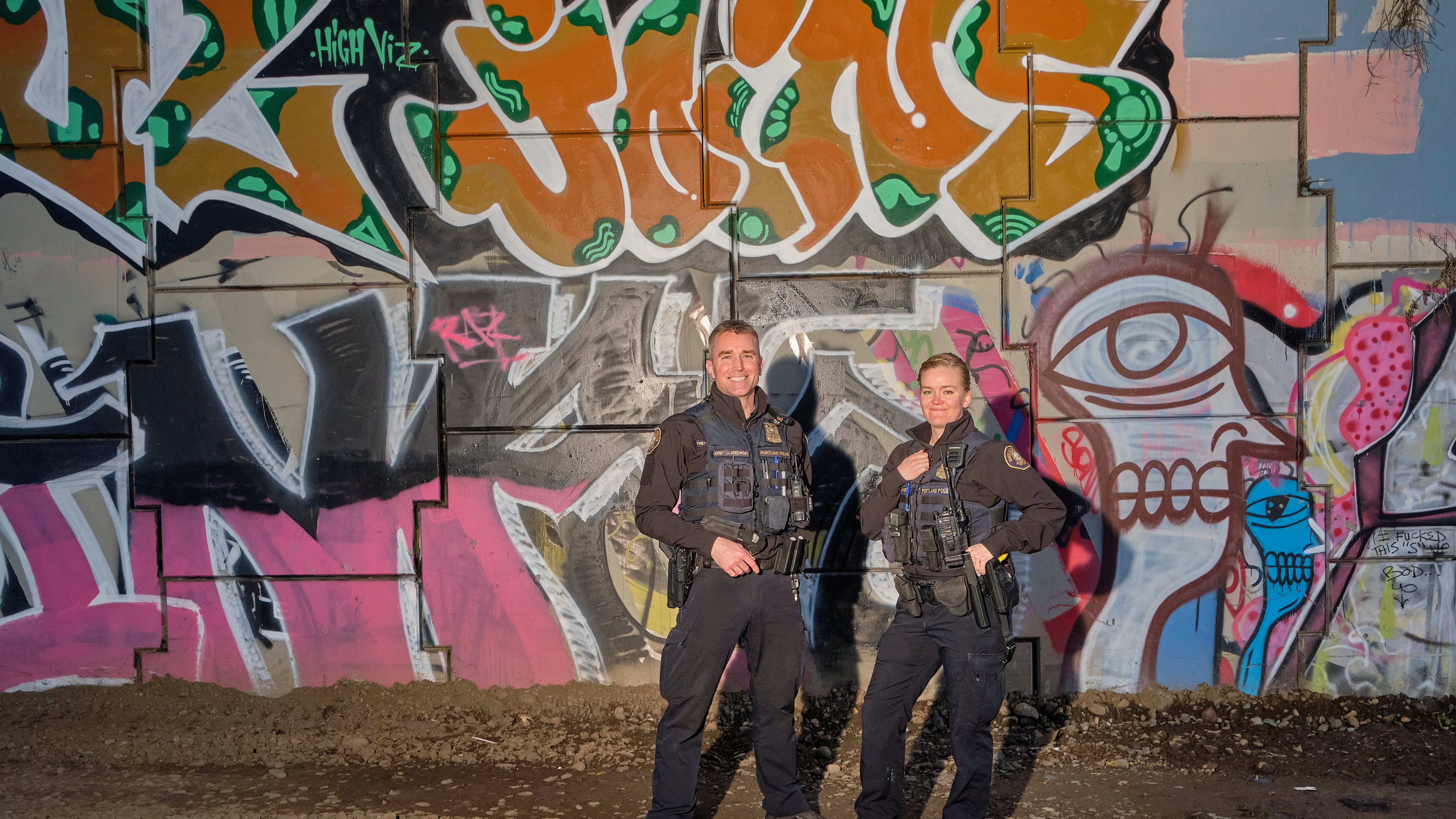Officer Nate Kirby-Glatkowski thinks most of the graffiti in Portland is being put up by fewer than 100 people, and maybe 50 hardcore taggers are applying most of the paint.
He and his partner, Amelia Flohr, are on a mission to arrest all of them.
In his previous life, Kirby-Glatkowski, or KG as he’s known on the force, worked at a nonprofit that tried to get the world’s nuclear powers to disarm. Stopping a small army of graffiti artists from tagging every surface in Portland seems easy by comparison, he says.
“We go after the most impactful folks,” Kirby-Glatkowski says.
They scored a high-profile victory Jan. 30 when, at the behest of Multnomah County District Attorney Mike Schmidt, a grand jury indicted Jerry Mijangos, a graffiti vandal that Kirby-Glatkowski and Flohr had been pursuing for years, seeing his enormous and amateurish tags go up on buildings and along freeways all over town. (More on Mijangos below.)
Drive around with Kirby-Glatkowski, 43, and Flohr, 28, for a morning, and you start to see patterns in all the paint. Here’s OMEGA. There’s GEOMETRO. There’s the notorious TENDO (aka Emile Laurent, a skateboarder they caught in 2022).
Kirby-Glatkowski and Flohr know a lot about the tags and the people who produce them. They read them like archaeologists deciphering hieroglyphics. TENDO always has a double stem in his T and often a figure 8 in his O. Knowing this helped find both TENDO’s “pieces” (big, time-intensive works) and his “throws,” quick hits letting people know he’s “up” all over the city. To the untrained eye, the two types are tough to link to one person.
Kirby-Glatkowski and Flohr know a fair amount about tagger habits, too. TWIN often tags with THRASHER. BIER always goes with a friend. CAM1 tags in broad daylight.
“It’s puzzle-solving,” Kirby-Glatkowski says.
Deciphering tags is important because each one becomes a criminal charge, and they need enough charges to come up with an indictment that will deter the vandal in question. Spraying graffiti is considered criminal mischief if it causes property damage. The damage must be greater than $1,000 for the crime to be a felony. Otherwise, it’s a misdemeanor. A tagger’s flourishes, like backward letters, serifs or numbers standing in for letters, help cops link multiple tags to a single person.
Like most experts in the field, Kirby-Glatkowski says the best way to rid the city of graffiti, beyond arresting offenders, is to buff it regularly. “Buff” is tagger slang for clean off or paint over. “Taggers want to be up,” he says. “They don’t want to be buffed.” But local governments have struggled to remove most of what’s scrawled on the urban landscape (“Spray Anything,” WW, Jan. 31).
The Portland Police Bureau had a dedicated graffiti squad until 2015, when it was disbanded because of staffing shortages. Kirby-Glatkowski started patrolling the paint about two and a half years ago, and Flohr joined him six months after that.
They spend about 10% of their time on graffiti. They’d like to spend more. The pair relies other officers, especially from the Central Precinct Neighborhood Response Team and its Bike Squad, for help.
“It’s a social ill,” Kirby-Glatkowski says, navigating his police SUV around deep potholes on a dirt road beside Interstate 5. “It’s indicative of criminal permissiveness. It emboldens people who have criminal mindsets, and disheartens people who don’t have criminal mindsets.”
The tagger who put Kirby-Glatkowski on the offensive was Adam Tucker, aka the Bridge Monster. In the summer of 2021, at the height of the pandemic, Tucker would hit Portland’s bridges with his tag—BSE MVP 503—and post Instagram videos of his work that included his real name and address. (In one, he lays a tag across four lanes of the Fremont Bridge. The caption: LEGEND SHIT ME TAGGING FREMONT BRIDGE TOP DECK.)
“It was just so beyond the pale,” Kirby-Glatkowski says.
Fed up, Kirby-Glatkowski went after the Bridge Monster. Police staked out his house in East Portland and caught him riding an e-bike with panniers full of spray paint, according to court records. Tucker told Kirby-Glatkowski he did graffiti to protest police brutality.
When Flohr partnered with Kirby-Glatkowski, she caught the graffiti bug, too. “Once you start looking, it’s like the weirdest version of Where’s Waldo? you can imagine,” she says.
Here is a sampling of some of the most prominent tags that are up around town right now, and who’s behind them. There are plenty of others out there—KHETS, CASEIN, KABOB, SLUG and NOTICE—who are up everywhere and “very busy,” according to Kirby-Glatkowski. If he and Flohr know who they are, they aren’t saying—yet.
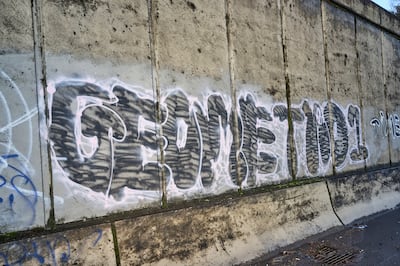
GEOMETRO
Aiden Saul, 22
Cops picked up Aiden Saul in November 2022. He was using white paint to spray GEOMETRO on an overpass near Northeast Halsey Street and 82nd Avenue, where it could be seen by traffic on Interstate 84 passing below (the bigger the audience, the better in taggerland). Questioned by officers, Saul said he was an artist who worked in watercolors, despite the fact that he was carrying four cans of spray paint and had fresh paint on his clothes, according to court documents. Officers looked around and found wet tags on the overpass wall, four traffic signs, and a utility pole. Officers estimated it would cost more than $1,000 to remove or paint over them. That case was dismissed because of the shortage of public defenders in Portland, but Kirby-Glatkowski and Flohr didn’t give up. They found 50 more GEOMETROs around town, searched Saul’s apartment, and referred 24 incidents to the DA’s Strategic Prosecution and Services Unit. They expect an indictment in March.
CAM1
Cameron Johnson-Jung, 23
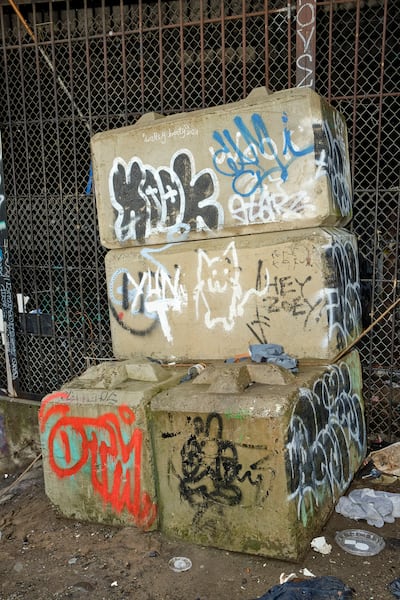
Say what you will about Cameron Johnson-Jung, but he’s persistent. Unlike most taggers, Johnson-Jung tags in broad daylight. “He’s been arrested three times in six months and keeps putting up tags,” Kirby-Glatkowski says. Last June, cops caught him tagging the graffiti-covered abandoned building at Southeast 49th Avenue and Hawthorne Boulevard. Six months later, they nabbed him writing “CAM” on the side of a building on Southeast 82nd in Montavilla on Dec. 1. (The owner, agitated, came out and said he “was angry that vandals never get in trouble,” according to the arresting officer’s affidavit.) That arrest didn’t stop Johnson-Jung, either. In February, court documents allege, he went into the Westmoreland Ace Hardware store on Southeast Milwaukie Avenue, grabbed several cans of spray paint, and walked past the registers. He allegedly pushed a manager to the ground and started tagging a TriMet bus shelter across the street, where the cops caught him. A grand jury indicted him Feb. 8 on charges of criminal mischief, robbery and theft.
OMEGA
Gabriel Rodriguez-Lee, 21
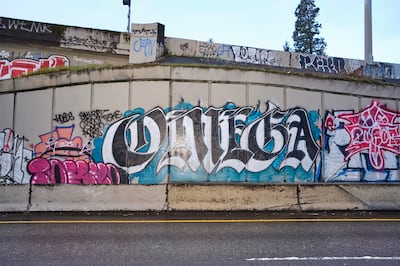
Look closely, and you’ll see a lot of OMEGA tags around town. His stuff is more polished than most, suggesting he takes some time, even standing in the middle of the I-84 exit ramp north off of I-5, one of the busiest roadways in Oregon. Gabriel Rodriguez-Lee was putting up a big OMEGA tag on a fence owned by the city off I-5 in North Portland in October when the cops rolled up. Rodriguez-Lee ran and ditched a backpack that contained spray paint and other “graffiti accessories,” according to the DA’s office. The pack also had a secret compartment where Rodriguez-Lee kept a ghost gun (an untraceable firearm without a serial number, made from parts bought on the internet) and a loaded magazine. He admitted to cops that the backpack and OMEGA tag were his. He didn’t have a concealed carry permit. He was charged with criminal mischief and unlawful possession of a firearm on Oct. 10. He pleaded guilty in November and got 12 months’ probation.

BIER
Jacob Ramos, 44
Ramos is old school and, well, old for a tagger, at 44. Kirby-Glatkowski and Flohr know a lot about him. He always tags with a friend, for one thing, and is part of the Kill Your Television, or KYT, krew (taggerspeak for a graffiti club). And he thinks artists who paint murals are sellouts whose work must be defaced. For the longest time, he tagged with a woman named Shelaleh Rostami, aka THUJA, who had pleaded guilty to graffiti charges in 2016. In April 2022, a surveillance camera caught a man and a woman painting over a new mural on Platinum Records, Lights & Sound on Southwest 2nd Avenue downtown. They recognized the tag THUJA and found it on an Instagram account later that day. An odyssey of THUJA tags in New York and Philadelphia, and a subpoena of Meta, Instagram’s parent, led police to a house in Beaverton, where they found Rostami. In her phone, they found conversations with Ramos. They searched his house in East Portland and found a photo of his BIER tag on an abandoned building, cans of spray paint, and respirators (safety first!). They also found a cottage industry cranking out ghost guns. Ramos had a 3D printer (paused midgun), a drill press, a router and an arsenal. Ramos was indicted on 90 counts, including 11 for manufacturing, importing or transferring a firearm, 17 for being a felon possessing guns, and 62 for criminal mischief (all the BIER tags that cops had found). Since the indictment, Kirby-Glatkowski and Flohr haven’t seen any new BIER tags. But there’s a new JOINS on a concrete pillar holding up I-84, with “KYT” in the upper left corner, so JOINS (identity unknown) is keeping Ramos’ krew up in Stumptown.
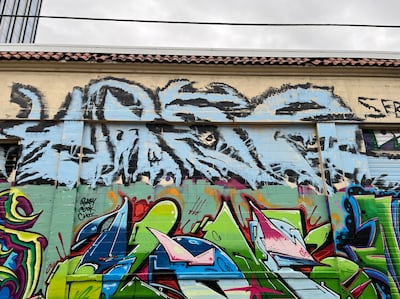
KASR
Jerry Mijangos, 27
Mijangos seems to pride himself more on where he puts his tags than on how they look. Many are done with a paint roller but look like they were applied with a mop. And, unfortunately, they tend to be huge. In 2021, cops found a KASR tag that was 10 feet wide and 6 feet tall. And Mijangos is up all over town. There’s a scribbled white KASR on a 30-foot-tall sign on the northwest corner of Southeast Powell and César E. Chávez boulevards. His pièce de résistance is probably a 30-foot-long light blue and black mess high up on a building at Southeast Ankeny Street and 3rd Avenue. Kirby-Glatkowski wanted him prosecuted more than just about anyone else. “He was the thorn in my side,” Kirby-Glatkowski says. “Most people stop because they have something to lose.” Not Mijangos. Kirby-Glatkowski arrested him in 2021, just after he put up his masterwork on Ankeny. Cops got him again in 2022. Seeing hundreds of new tags all over the city, they referred more cases to the DA last year. Police arrested Mijangos on Jan. 1, for violating probation. They stacked up more cases against him, and now he is in custody, facing eight counts of criminal mischief for tagging an O’Reilly Auto Parts, a Public Storage, a highway, Steam Portland and Spartacus, the sex shop.
